Time-based licensing in photography grants usage rights for a specific period, ideal for short-term projects or campaigns needing limited access. Perpetual licensing offers indefinite usage rights, allowing photographers and clients to use images without expiration, perfect for long-term or evergreen content. Choosing between them depends on budget, project duration, and intended image lifespan, impacting both flexibility and cost efficiency.
Table of Comparison
| Feature | Time-Based Licensing | Perpetual Licensing |
|---|---|---|
| Usage Duration | Limited to a fixed period (e.g., 1 year) | Unlimited, lifetime use |
| Cost Structure | Recurring fees (subscription) | One-time payment |
| Content Updates | Includes updates during license period | Updates often excluded or paid separately |
| Rights | Temporary usage rights | Permanent usage rights |
| Ideal For | Short-term projects, flexible budgets | Long-term projects, permanent access |
| Renewal | Required to continue usage | No renewal needed |
Understanding Time-Based Licensing in Business Photography
Time-based licensing in business photography grants clients the right to use images for a specific duration, enhancing flexibility and budgeting control. This model is ideal for marketing campaigns, seasonal promotions, or projects with defined timelines, ensuring legal clarity on usage periods. Photographers benefit from recurring revenue opportunities, while clients avoid long-term commitments associated with perpetual licenses.
What is Perpetual Licensing? Key Features and Benefits
Perpetual licensing in photography grants lifetime access to images without ongoing fees, allowing unlimited usage after a one-time payment. Key features include permanent rights to use the photograph across multiple projects, no expiration date, and flexibility in adapting the image for various creative needs. Benefits encompass cost-effectiveness for long-term projects, freedom from recurring charges, and the ability to build a permanent image library enhancing creative control.
Comparing Time-Based and Perpetual Licensing Models
Time-based licensing for photography offers flexibility by granting usage rights for a specific period, ideal for short-term projects or campaigns. Perpetual licensing provides indefinite usage rights, giving photographers and clients long-term access to images without recurring fees. Choosing between these models depends on budget, project duration, and the desired control over image usage rights.
Cost Analysis: Which Licensing Type is More Economical?
Time-based licensing often offers lower upfront costs and flexibility for photographers needing short-term use, making it economical for occasional projects. Perpetual licensing demands higher initial investment but provides unlimited usage rights, becoming cost-effective over long-term or repeated applications. Evaluating project frequency and budget constraints is essential to determine the most cost-efficient licensing model.
Flexibility and Control: Evaluating Usage Rights
Time-based licensing offers photographers enhanced flexibility with usage rights limited to a specific duration, allowing clients to use images temporarily without long-term commitments. Perpetual licensing grants indefinite control over image use, providing ongoing rights with fewer restrictions but often at a higher upfront cost. Evaluating these options requires balancing client needs for short-term campaigns against long-term brand assets to maximize both flexibility and control in image deployment.
Legal Considerations in License Agreements
Time-Based Licensing restricts the usage rights of photographs to a specified period, ensuring compliance with copyright duration and preventing unauthorized perpetual use. Perpetual Licensing grants indefinite usage rights, requiring clear contractual terms to avoid disputes over ownership and distribution rights. Legal considerations must address termination clauses, renewal options, and scope of use to safeguard photographers' intellectual property and clients' usage expectations.
Client Needs: Matching Licensing Types to Business Objectives
Time-based licensing offers clients flexibility by granting usage rights for a specific duration, ideal for short-term campaigns or seasonal promotions. Perpetual licensing provides indefinite usage rights, aligning with long-term branding strategies and ongoing marketing needs. Matching licensing types to business objectives ensures clients maximize value by choosing agreements that reflect the intended scope and longevity of their photographic content.
Impact on Photographer Revenue Streams
Time-based licensing provides photographers with recurring revenue by charging clients for usage over a specified period, ensuring continuous income as long as the license is renewed. Perpetual licensing offers a one-time payment, granting clients indefinite use of the images, which can result in immediate but finite revenue for photographers. Revenue predictability is higher with time-based licenses, while perpetual licenses may lead to larger upfront earnings but limit long-term income potential.
Best Practices for Negotiating Licensing Terms
When negotiating photography licensing terms, clearly defining the scope and duration of time-based licenses ensures precise usage rights and prevents unauthorized extensions. Establishing specific geographic and media restrictions within perpetual licenses can protect the photographer's work while maximizing client flexibility. Incorporating renewal options and usage audits into contracts helps maintain control over intellectual property and supports fair compensation over time.
Industry Trends: The Shift Towards Time-Based Licensing
Photography industry trends reveal a significant shift towards time-based licensing, driven by increasing demand for flexible usage terms and budget-friendly options. Time-based licensing allows photographers and clients to negotiate licenses for specific durations, enhancing adaptability in content distribution across digital platforms. Market data shows growing adoption of subscription models and limited-term licenses, reflecting evolving consumer preferences and technological advancements.
Time-Based Licensing vs Perpetual Licensing Infographic

 bizdif.com
bizdif.com